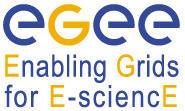CeBIT Open Source Project Lounge -- EGEE
EGEE - Enabling Grids for EsciencE
ByEGEE is among the 15 projects that will present their work at CeBIT. Initiated by the European Union, the project has created a worlwide infrastructure of computing clusters.

In a nutshell - how would you describe your project in a few words?
EGEE has built a worldwide infrastructure of computing clusters in which currently around 150,000 CPU cores in 260 computer centers run over 330,000 programs daily. Almost all systems run under Scientific Linux, their interaction coordinated through gLite open source middleware.
When did the project begin?
The EU project Enabling Grids for E-sciencE (EGEE) began its work May of 2004. It is supported by the various research work of the European Data Grid project that got its start in 2002.
How many active members does the project have?
In development and infrastructure operations, as well as work on the associated grid middleware, more than 9,000 man-months have been invested over the two years of the current project phase. There are 14,000 registered users worldwide.
How did the project come about?
The EGEE initiative emerged out of the recognition that the processing of huge amounts of data from the various scientific research branches requires a distributed, coordinated working and commonly usable computing infrastructure. In this way the experiments at the Large Hadron Collider in Geneva alone produce between 10 and 40 Petabytes of data, which needs to be accessible at any moment by many thousands of researchers who require the applicable computing resources at hand for their repeated operations. The European Union invested significant resources in creating and maintaining the infrastructure and software environment.
What would make a CeBIT visitor interested in your booth?
The EGEE infrastructure is seen today by many as the "real existing" grid. A visit to our booth would provide insight into how this grid functions and the applications that are relevant for such an environment.
Who do you make your software for?
The software is primarily used for scientific research, but is provided free under Apache licensing for any interested party.
Where do you see your biggest current challenge?
It seems necessary for the successful further development of the gLite middleware that a broad user and developer community apart from core users from the scientific realm are involved.
If you were to hire a full-time project developer now, what problem should he or she be ready to solve?
To disseminate the concepts implemented in gLite based on the demands of the established scientific user community.
Under which license is the software currently offered?
Apache License, version 2.0.
Internet adress: http://www.eu-egee.org (see also http://gridportal.hep.ph.ic.ac.uk/rtm).
Subscribe to our Linux Newsletters
Find Linux and Open Source Jobs
Subscribe to our ADMIN Newsletters
Support Our Work
Linux Magazine content is made possible with support from readers like you. Please consider contributing when you’ve found an article to be beneficial.

News
-
Two New Distros Adopt Enlightenment
MX Moksha and AV Linux 25 join ranks with Bodhi Linux and embrace the Enlightenment desktop.
-
Solus Linux 4.8 Removes Python 2
Solus Linux 4.8 has been released with the latest Linux kernel, updated desktops, and a key removal.
-
Zorin OS 18 Hits over a Million Downloads
If you doubt Linux isn't gaining popularity, you only have to look at Zorin OS's download numbers.
-
TUXEDO Computers Scraps Snapdragon X1E-Based Laptop
Due to issues with a Snapdragon CPU, TUXEDO Computers has cancelled its plans to release a laptop based on this elite hardware.
-
Debian Unleashes Debian Libre Live
Debian Libre Live keeps your machine free of proprietary software.
-
Valve Announces Pending Release of Steam Machine
Shout it to the heavens: Steam Machine, powered by Linux, is set to arrive in 2026.
-
Happy Birthday, ADMIN Magazine!
ADMIN is celebrating its 15th anniversary with issue #90.
-
Another Linux Malware Discovered
Russian hackers use Hyper-V to hide malware within Linux virtual machines.
-
TUXEDO Computers Announces a New InfinityBook
TUXEDO Computers is at it again with a new InfinityBook that will meet your professional and gaming needs.
-
SUSE Dives into the Agentic AI Pool
SUSE becomes the first open source company to adopt agentic AI with SUSE Enterprise Linux 16.
